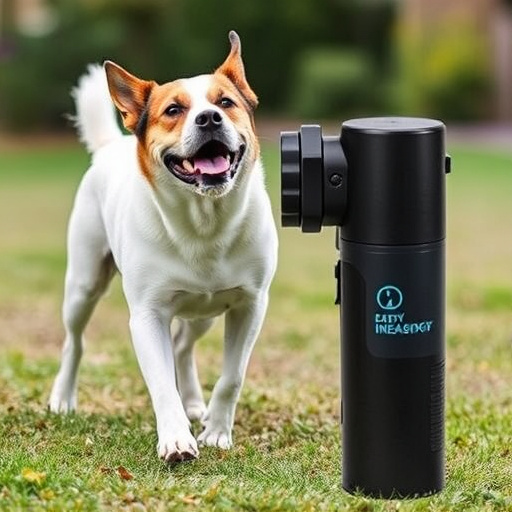Animal control sprays, like pepper spray and capsaicin-based repellents, require careful handling due to their potential severity on dogs, especially around sensitive areas. In case of exposure, immediate action is crucial for removing pepper spray from a dog's eyes. This involves flushing with lukewarm water for 15 minutes, using mild eye washes, and monitoring for irritation. Preventative measures like training, alternative repellents, and proper pet identification are key to avoiding such incidents.
Professional-strength animal control spray, like pepper spray, can be an effective tool for deterring unwanted wildlife. However, understanding its impact on animals is crucial, especially when it comes to dogs. This article delves into the science behind pepper spray irritation in dogs and offers practical advice on safe removal techniques for removing pepper spray from a dog’s eyes. We also explore preventative measures like training and alternative solutions, empowering you with knowledge to handle these situations responsibly.
- Understanding Animal Control Sprays: Types and Uses
- The Science Behind Pepper Spray Irritation in Dogs
- Safe Removal Techniques for Pepper Spray from Dog Eyes
- Preventative Measures: Training and Alternative Solutions
Understanding Animal Control Sprays: Types and Uses
Animal control sprays, also known as pepper spray or capsaicin-based repellents, are specialized products designed to deter and manage animal behavior, particularly in situations involving wild or aggressive animals. These sprays come in various strengths and formulations, each suited for different applications. From professional wildlife management to domestic pet training, understanding the types and uses of these sprays is essential.
One common application involves removing pepper spray from dog eyes, a scenario that highlights the importance of knowing your spray’s composition. While capsaicin, the active ingredient in pepper spray, effectively deters animals by irritating their sensory organs, it can also cause discomfort if inadvertently directed towards sensitive areas like the eyes. Professional-strength sprays often come with specific instructions and safety measures for handling and application to ensure both animal and user safety.
The Science Behind Pepper Spray Irritation in Dogs
The irritation caused by professional-strength animal control spray, often pepper spray, in dogs is a result of capsaicin, the active ingredient found in chili peppers. When inhaled or in contact with mucous membranes like the eyes and nose, capsaicin triggers nerve endings, leading to intense burning sensations and inflammation. This reaction can be particularly severe in dogs due to their sensitive respiratory system and the high concentration of pepper spray used by professionals.
In the case of pepper spray getting into a dog’s eyes, quick action is essential. Rinsing the eyes with plenty of lukewarm water for at least 15 minutes helps dilute and remove the capsaicin. It’s crucial to avoid using harsh solutions or trying to clean the eyes with a cloth as it may further irritate the sensitive eye tissue. Always seek veterinary care if irritation persists, as they can provide specialized treatment to soothe and protect your dog’s eyes from the harmful effects of pepper spray.
Safe Removal Techniques for Pepper Spray from Dog Eyes
When a dog comes into contact with animal control spray, especially in the sensitive eye area, prompt and safe removal techniques are crucial to prevent discomfort or potential damage. The first step is to flush the eyes thoroughly with copious amounts of clean water for at least 15 minutes. This helps to dilute and wash away the pepper spray particles. Hold the dog’s head under a gentle stream of water, ensuring that both eyes are well-rinsed.
After initial flushing, you can use a mild, dog-safe eye wash or solution to further clean the eyes. Always check with a veterinarian for recommendations on suitable products. Gently wipe away any visible residual spray using soft, damp cloths or cotton balls, being extra careful around the eye area. Regularly monitor the dog’s eyes for any signs of irritation, redness, or discomfort, and seek veterinary care if issues persist.
Preventative Measures: Training and Alternative Solutions
Preventative measures are key in managing and avoiding unwanted animal interactions, especially with potentially aggressive species. Training plays a pivotal role here; teaching both animals and humans how to recognize and respond appropriately to each other’s cues can prevent many conflicts. For instance, training dogs to stay away from certain areas or to respond to specific commands when encountering unfamiliar animals can be highly effective.
Alternative solutions are also worth exploring before resorting to chemical deterrents like pepper spray. This includes creating physical barriers, such as secure fences, and using sound or scent-based repellents. For dog owners, ensuring their pets wear properly fitted collars with identification tags and considering microchipping can help prevent accidental encounters that might lead to the use of animal control spray, including removing pepper spray from a dog’s eyes if it does occur.
Animal control sprays, particularly pepper spray, can be effective in managing aggressive canine behavior. However, it’s crucial to understand their impact on dogs’ senses and eye safety. After discussing removal techniques for pepper spray from dog eyes, we emphasize the importance of preventative measures like training and alternative solutions to ensure a safer and more humane approach. By combining these strategies, pet owners can effectively navigate interactions with potentially aggressive dogs while promoting positive canine-human relationships. Remember, proper handling and understanding are key to both controlling animals and safeguarding their well-being.
